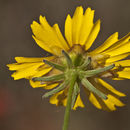Comments
provided by eFloras
Coreopsis nuecensis is probably in Mexico (Tamaulipas) and was collected once in Florida ("Escaped from cultivation"). Plants with glabrous phyllaries and chromosome numbers of 2n = 18 and 20 and included here in C. nuecensis have been called C. nuecensoides.
- license
- cc-by-nc-sa-3.0
- copyright
- Missouri Botanical Garden, 4344 Shaw Boulevard, St. Louis, MO, 63110 USA
Description
provided by eFloras
Annuals, 10–30(–50+) cm. Aerial nodes proximal to first peduncle usually 1–3(–5), distalmost 1–3 internodes 2–4(–9+) cm. Leaves: basal and cauline on proximal 1/5–1/3(–1/2) of plant heights; petioles 1–8+ cm; blades simple or 1(–2)-pinnately lobed, simple blades or terminal lobes ± elliptic to lanceolate, 10–30 × 5–15 mm. Peduncles (5–)10–25+ cm. Calyculi of ± deltate to lance-oblong bractlets 4–6(–8) mm. Phyllaries lance-oblong, 6–8(–10+) mm. Ray laminae yellow, usually each with (2–)4–8+ proximal, red-brown or purple flecks, 12–18+ mm. Disc corollas 2.5–3.2 mm, apices yellow. Cypselae 2.5–4 mm, wings spreading, ± chartaceous, entire. 2n = 12, 14, 18, 20.
- license
- cc-by-nc-sa-3.0
- copyright
- Missouri Botanical Garden, 4344 Shaw Boulevard, St. Louis, MO, 63110 USA
Synonym
provided by eFloras
Coreopsis coronata Hooker, Bot. Mag. 63: plate 3460. 1836, not Linnaeus 1763; C. nuecensoides E. B. Smith
- license
- cc-by-nc-sa-3.0
- copyright
- Missouri Botanical Garden, 4344 Shaw Boulevard, St. Louis, MO, 63110 USA
Coreopsis nuecensis: Brief Summary
provided by wikipedia EN
Coreopsis nuecensis, the crown tickseed, is a North American plant species of Coreopsis in the family Asteraceae. It is native to Texas, Louisiana, and probably Tamaulipas. There are reports of isolated populations in Michigan and Florida, both probably escapes from cultivation.
Coreopsis nuecensis is an annual herb up to 50 cm (20 inches) tall. Ray florets are yellow with red or purple flecks; disc florets are yellow. The species grows in sandy soil in open woodlands.
- license
- cc-by-sa-3.0
- copyright
- Wikipedia authors and editors

